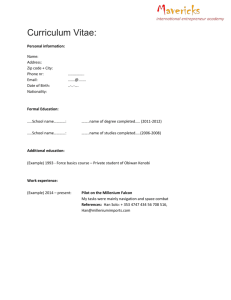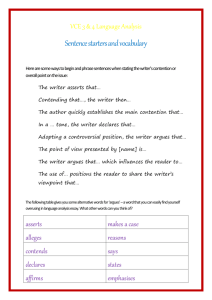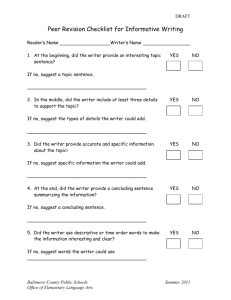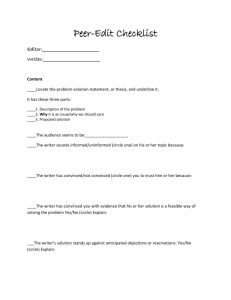Feature Article Rubric
advertisement
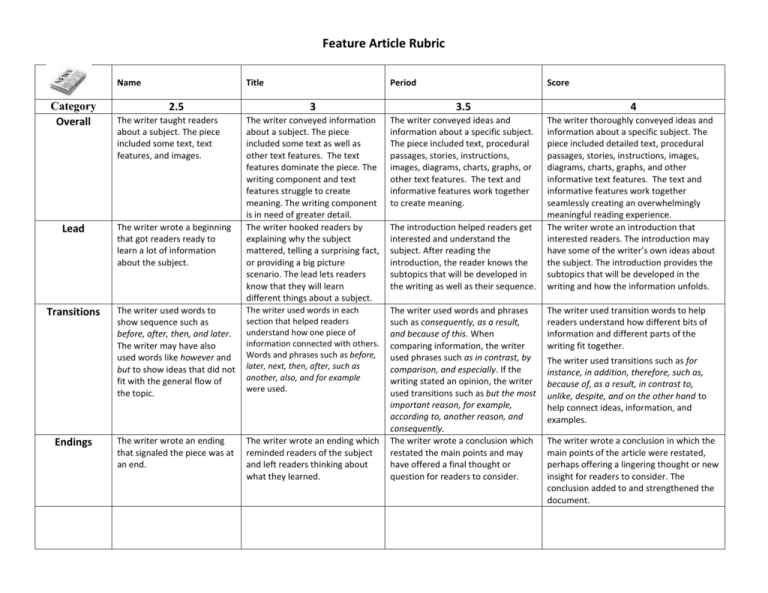
Feature Article Rubric Name Category Overall Title 2.5 The writer taught readers about a subject. The piece included some text, text features, and images. Lead The writer wrote a beginning that got readers ready to learn a lot of information about the subject. Transitions The writer used words to show sequence such as before, after, then, and later. The writer may have also used words like however and but to show ideas that did not fit with the general flow of the topic. Endings The writer wrote an ending that signaled the piece was at an end. Period Score 3 3.5 4 The writer conveyed information about a subject. The piece included some text as well as other text features. The text features dominate the piece. The writing component and text features struggle to create meaning. The writing component is in need of greater detail. The writer hooked readers by explaining why the subject mattered, telling a surprising fact, or providing a big picture scenario. The lead lets readers know that they will learn different things about a subject. The writer used words in each section that helped readers understand how one piece of information connected with others. Words and phrases such as before, later, next, then, after, such as another, also, and for example were used. The writer conveyed ideas and information about a specific subject. The piece included text, procedural passages, stories, instructions, images, diagrams, charts, graphs, or other text features. The text and informative features work together to create meaning. The writer thoroughly conveyed ideas and information about a specific subject. The piece included detailed text, procedural passages, stories, instructions, images, diagrams, charts, graphs, and other informative text features. The text and informative features work together seamlessly creating an overwhelmingly meaningful reading experience. The writer wrote an introduction that interested readers. The introduction may have some of the writer’s own ideas about the subject. The introduction provides the subtopics that will be developed in the writing and how the information unfolds. The writer wrote an ending which reminded readers of the subject and left readers thinking about what they learned. The introduction helped readers get interested and understand the subject. After reading the introduction, the reader knows the subtopics that will be developed in the writing as well as their sequence. The writer used words and phrases such as consequently, as a result, and because of this. When comparing information, the writer used phrases such as in contrast, by comparison, and especially. If the writing stated an opinion, the writer used transitions such as but the most important reason, for example, according to, another reason, and consequently. The writer wrote a conclusion which restated the main points and may have offered a final thought or question for readers to consider. The writer used transition words to help readers understand how different bits of information and different parts of the writing fit together. The writer used transitions such as for instance, in addition, therefore, such as, because of, as a result, in contrast to, unlike, despite, and on the other hand to help connect ideas, information, and examples. The writer wrote a conclusion in which the main points of the article were restated, perhaps offering a lingering thought or new insight for readers to consider. The conclusion added to and strengthened the document. Feature Article Rubric Organization The writer grouped information into parts. Each part was mostly about one thing that connected to the larger subject. Headings and subheadings would have been useful. Text features were included but lacked purpose and meaning. The writer grouped information into sections and used paragraphs and evidence to support each section. Each section was mostly about the same thing. Some text features were included. The writing included headings and subheadings. The writer arranged topics with supporting paragraphs and used evidence and explanation to support those topics. The writing moves from one topic to another. The text features are carefully placed in the document and help convey meaning. The headings and subheadings help the reader understand the overall meaning of the piece. The writer arranged many topics with multiple paragraphs and a variety of evidence and explanation to support those topics. The writing flows easily from one topic to the next. The text features are purposely placed in the document and enhance the meaning of the text. The headings and subheadings make the piece easy to read and more meaningful. Elaboration The writer wrote some facts, details, and observations about a subject. The writer chose a subject and taught readers about that subject. Different topics were discussed using text. The writer used some facts, example, and details. The writing included some information from research but mostly relied on the writer’s previous knowledge. The writer chose a focused subject and included topics, details, and elaboration. Each topic included paragraphs with supporting details. The evidence and explanations included research from credible sources and/or information from experts. The source of the information was made clear in the text. Craft The writer presented some information about a subject. The writer explained the subject in a way that was interesting but could have used more domain-specific vocabulary. Some text features were present but lacked meaning and effectiveness. The voice and tone of the writing was too casual. The writer presented ideas and made some decisions about how information supports the topics and subject. Some domainspecific vocabulary was used. Some text features were included. The voice and tone of the writing could be more consistent. The writer chose how to present information to support topics and the overall subject. The writer chose interesting words to explain information and ideas. The writing included domain-specific vocabulary. The writer included phrases, comparisons, and summaries to communicate ideas. Text features like images, diagrams, charts, graphs, captions, and drawings were used to enhance meaning. The writer used a consistent voice throughout the piece. The writer chose a focused subject and included a variety of topics, details, and ample elaboration. Each topic included multiple paragraphs which were explained in great detail. The evidence and explanations included research from credible sources and information drawn from authorities on the subject. The source of the information was made clear in the text or a bibliography was included at the end of the document. The writer carefully and purposefully chose how to present information to clearly support topics and the overall subject. The writer chose words carefully to explain information and ideas. The writer included a multitude of domain-specific vocabulary and explained these terms. The writer included exact phrases, comparisons, and summaries to effectively communicate ideas. Elaborate text features like images, diagrams, charts, graphs, captions, and drawings were used to enhance meaning. The writer used a consistent, inviting teaching voice. Feature Article Rubric Spelling Grammar and Punctuation Capitalization Editing Publishing The writer used knowledge about word patterns to spell correctly. Resources like dictionaries and word walls could have been utilized more. There are a multitude of errors. The writer used sentences that are incomplete and do not follow the rules of grammar and punctuation. There are many run-ons and fragments. There is little sentence variety present in the writing. Many sentences are choppy and difficult to read. The writer did not capitalized words at the beginning of sentences and for all proper nouns. The writer had difficulty capitalizing titles and headings correctly. The piece has a multitude of mistakes. The writer could spend more time and effort on editing and proofreading. There are numerous errors and mistakes. The presentation of writing has major issues. There are problems with size and choice of font. The paragraphs are not indented. There are numerous formatting issues. Titles and headings have major formatting issues. The writer mostly used knowledge about word patterns to spell correctly. Resources like dictionaries and word walls could have been utilized more. There are many errors. The writer used resources like dictionaries and word walls to be sure words are spelled correctly. There are one or two minor errors. The writer used resources like dictionaries and word walls to be sure words are spelled correctly. There are no errors. The writer mostly used sentences that are complete and follow the rules of grammar and punctuation. However, there are some run-ons and fragments. Some sentences are choppy and difficult to read. Sentence structure is basic and lacks variety. The writer attempted to use introductory elements, interruptions, compound sentences, and other sentence structures. However, the punctuation may be missing, lack consistency, or be incorrect. Sentences mostly follow the rules of punctuation and grammar. Most sentences are fluent and well-structured. The writer capitalized most words at the beginning of sentences and proper nouns. The writer capitalized titles and headings correctly. There may be one or two mistakes. The writer used introductory elements, interruptions, compound sentences, and other sentence structures. All sentences are complete and follow the rules of grammar and punctuation. Sentences are fluent and well-structured. A variety of sentence structures and types are used and are punctuated correctly. The writer spent a great deal of time proofreading and editing. The writer utilized editing and proofreading resources to enhance the writing. There are one or two errors or mistakes. The writer spent a great deal of time proofreading and editing thoroughly. The writer consistently utilized editing and proofreading resources to enhance and perfect the writing. The final product is of exceptional quality. Writing is neat and presentable. Paragraphs are indented, but there are some minor formatting issues. Titles and headings are included but may also have some minor formatting issues. Writing is neat and presentable. Paragraphs are indented. Titles and headings are formatted correctly, are consistent throughout the piece, and have style. The writer may have not capitalized words at the beginning of sentences and for all proper nouns. The writer may have had difficulty capitalizing the titles and headings correctly. There are many mistakes. The writer spent some time proofreading and editing. The writer utilized editing and proofreading resources to enhance the writing. However, there are many errors and mistakes. The presentation of writing may have some issues. There may be paragraph format problems or other obvious formatting issues. Titles and headings are included but may also have some formatting issues. The writer capitalized words at the beginning of sentences and for all proper nouns. The writer capitalized titles and headings correctly. There are no capitalization mistakes. Feature Article Rubric



